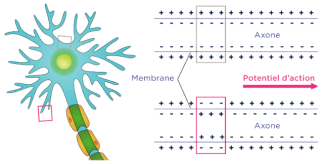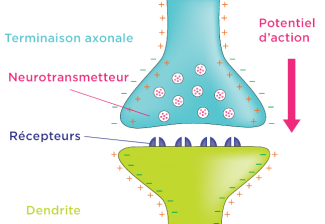Transient and rapid change in the electrical potential at the surface of a cell.
When a neuron is activated either by an “order” received from the brain or by “information” received from the periphery (an image, a pain, a sound….) an exchange of calcium and sodium ions occurs between the neuron’s interior and exterior. This ion exchange causes an electrical current, the action potential, which travels along the neuron’s axon to another neuron.

The synapse allows the action potential, also called nerve influx, to move from neuron to neuron. Each neuron can form synapses with several thousand other neurons.

The passage of nerve impulses occurs through neurotransmitters, molecules produced by the neuron itself, which are released at the end of the nerve terminal and captured by receptors anchored in the dendrites.
When a neurotransmitter clings to its receptor, it triggers a change in polarization on the dendrite and thus an action potential that spreads to the axon.
- Nervous Influx :
- A message that circulates from one neuron to another in electrical form, also known as an action potential.

